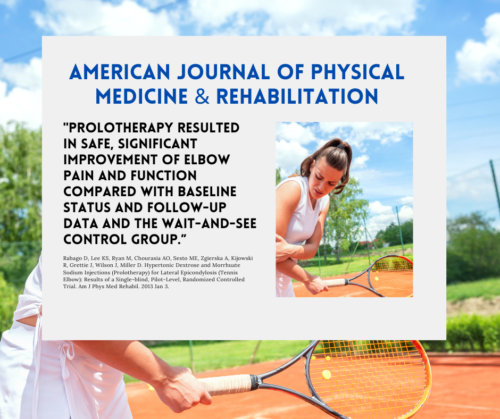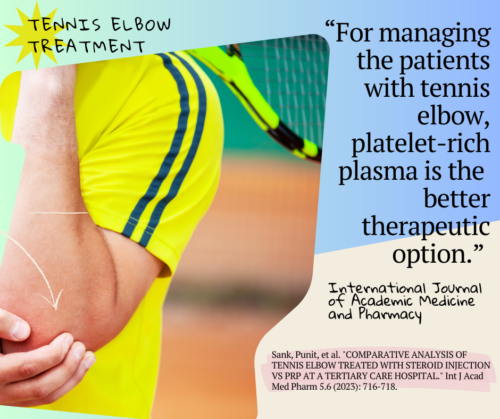 Tennis Elbow Treatment
Tennis Elbow TreatmentYou don’t have to be a tennis player to have tennis elbow. Tennis elbow is a condition caused by overuse. Sufferers might be painters, writers, guitar players, or anyone who does an activity requiring repetitive use of the arm and elbow. In this article, we’ll delve into tennis elbow as well as tennis elbow treatment.
Tennis elbow pain may radiate from the outer elbow into the forearm and wrist. These symptoms may make daily activities difficult. Even simple tasks like turning a doorknob or picking up, holding, and gripping objects.
Over-the-counter pain medications, NSAIDs, cortisone injections, bracing, taping, physical therapy, and massage, may work to bring some relief. But when these fail to achieve the desired relief, and your elbow continues to hurt, it is time to seek reparative, regenerative treatments like Regenerative Orthopedics.
The medical terminology for tennis elbow is lateral epicondylitis. The “itis” at the end of this word suggests inflammation of the tendon where it attaches to the bony prominence of the elbow (the lateral epicondyle). However, in tennis elbow, there is not always evidence of inflammation. And because of that, there is some controversy about the treatment for the condition. The Journal of Shoulder and Elbow Surgery says this:
The Open Access Journal of Sports Medicine also notes the controversy:
When elbow pain is chronic, and has lasted for an extended amount of time, it is likely that the problem is tendinosis, a condition of tendon degeneration.
What does all of that mean? What is tendinopathy, tendonitis, or tendinosis?
Tendinopathy is a broad term often used to describe any problem with a tendon.
Tendonitis refers to inflammation of the tendon, and is actually a less common cause of tendon pain than you might think.
Tendinosis is the breakdown (degeneration) of the collagen fibers in the tendon. It happens slowly and is often the result of tendon overuse.
Tendinosis is therefore the chronic non-inflammatory degeneration of a tendon. The condition may develop as a result of chronic tendonitis or due to repetitive strain-injuries to a tendon without adequate time to heal. Tendinosis is a more common cause of tendon pain. Since inflammation is not the issue, the problem does not respond well to anti-inflammatories.
Overuse injuries are activity-related injuries linked to repetitive stress placed on the tendon, ligament or other joint structure. Doing too much of the same activity strains the soft tissue structures of the elbow. Using poor or improper technique while training or poor form when painting can overload the muscles, tendons, and ligaments, and cause an overuse injury.
Chronic elbow pain may be related to ligament, muscle, and tendon injury. In order to resolve the problem, all of these areas need to be addressed for alleviation of the pain.
It is possible that elbow pain is a result of injury of the elbow ligaments. When elbow ligaments are involved, they may be frayed, torn, or otherwise weakened. Why is it important to address the ligaments if tennis elbow is a tendon problem? Ligaments are dense bands of connective tissue that attach one bone to another. They hold the bones in place, and allow for a strong, stable base upon which the muscles contract and move the joint. When a tendon is injured, there is often ligament involvement as well, and these soft tissue structures need to be repaired to stop the problem.
When the ligaments are injured or weakened, they can cause strain on the tendon and other joint structures. This allows for excessive elbow movement and instability. In this cycle of instability, the tendons will attempt to hold the muscle to the bone, increasing stress, and increasing the possibility of injury to the tendon.
Bracing
The journal Prosthetics and Orthotics International (3) examined the popular counterforce brace in people with problems of lateral elbow tendinopathy and found that physical therapy had better results.
In fact, researchers have concluded that braces, sleeves, tapes, and elbow bands may just be a waste of money, and that they probably only provide placebo affects.(4)
The US National Institutes of Health Clinical Trial website says: “Despite its promise, there have been no high-quality studies evaluating the efficacy of arthroscopic tennis elbow release, bringing the actual efficacy of this procedure into question.” (5)
The British Journal of Sports Medicine has an article entitled: “Time to put down the scalpel?” It says,“Our published review highlighted the importance of sham surgery in randomized controlled surgical trials including those in tendinopathy. Compared with using a non-surgical control group, sham surgery equalizes the placebo effect of surgery and gives more realistic insights into the effectiveness of the actual surgical procedure in question.”(6)
Regenerative Orthopedics is a non-surgical treatment that effectively repairs the tendons and ligaments involved in tennis elbow. Prolotherapy is one type of Regenerative Orthopedics and studies show its effectiveness in treating tennis elbow.
Prolotherapy is an injection technique that works to regenerate the degenerated tendon and ligaments. The injection of simple dextrose mimics the natural healing response and stimulates healing growth factors to repair the tissue.
Prolotherapy is effective for tennis elbow! It works because it boosts the body’s healing abilities naturally. It works because it addresses the problem by repairing the injured soft tissue. And it works because it reduces or eliminates the symptoms.
A few studies comparing PRP to cortisone injections shows that is the better option, and that PRP provides better long-term improvement in function and pain levels. (10,11).

PRP Is A Better Option Than Cortisone
Prolotherapy and other Regenerative Orthopedics, such as PRP and Stem Cell Therapy, all strengthen the involved ligaments and tendons. These therapies stabilize the elbow, strengthen the elbow, address the instability, and put an end to the pain and symptoms of tennis elbow. Recommendations may be made for PRP and/or Stem Cell in more advanced cases, but all treatments would include Prolotherapy.
If tennis elbow is a condition you are currently facing, please reach out and give us a call. We would be happy to help you become symptom free.
(1) Boyer MI. Lateral tennis elbow:” Is there any science out there?.”Journal of Shoulder and Elbow Surgery. 1999;8(5):481-91.
(2) Lai WC, Erickson BJ, Mlynarek RA, Wang D. Chronic lateral epicondylitis: challenges and solutions. Open Access Journal of Sports Medicine. 2018;9:243.
(3) Shahabi S, Bagheri Lankarani K, Heydari ST, Jalali M, Ghahramani S, Kamyab M, Tabrizi R, Hosseinabadi M. The effects of counterforce brace on pain in subjects with lateral elbow tendinopathy: A systematic review and meta-analysis of randomized controlled trials. Prosthetics and Orthotics International. 2020 Jul 8:0309364620930618.
(4) Au IP, Fan PC, Lee WY, Leong MW, Tang OY, An WW, Cheung RT. Effects of Kinesio tape in individuals with lateral epicondylitis: a deceptive crossover trial. Physiotherapy Theory and Practice. 2017 Dec 2;33(12):914-9.
(5) Kroslak M, Murrell GAC. Surgical Treatment of Lateral Epicondylitis: A Prospective, Randomized, Double-Blinded, Placebo-Controlled Clinical Trial. Am J Sports Med. 2018 Mar 1:363546517753385. doi: 10.1177/0363546517753385.
(6) Millar, Neal L., George AC Murrell, and Paul Kirwan. “Time to put down the scalpel? The role of surgery in tendinopathy.” British Journal of Sports Medicine 54.8 (2020): 441-442.
(7) Rabago D, Lee KS, Ryan M, Chourasia AO, Sesto ME, Zgierska A, Kijowski R, Grettie J, Wilson J, Miller D. Hypertonic Dextrose and Morrhuate Sodium Injections (Prolotherapy) for Lateral Epicondylosis (Tennis Elbow): Results of a Single-blind, Pilot-Level, Randomized Controlled Trial. Am J Phys Med Rehabil. 2013 Jan 3.
(8) Shin J, Seo K-M, Kim D-K, Kim B-K, Kang SH. The effect of prolotherapy on lateral epicondylitis of elbow. J Korean Acad Rehabil Med. 2002;26:764–8.
(9) Zhu M, Rabago D, Chung VC, Reeves KD, Wong SY, Sit RW. Effects of Hypertonic Dextrose Injection (Prolotherapy) in Lateral Elbow Tendinosis: A Systematic Review and Meta-analysis. Archives of Physical Medicine and Rehabilitation. 2022 Feb 28.
(10) Xu Y, Li T, Wang L, Yao L, Li J, Tang X. Platelet-Rich Plasma Has Better Results for Long-term Functional Improvement and Pain Relief for Lateral Epicondylitis: A Systematic Review and Meta-analysis of Randomized Controlled Trials. Am J Sports Med. 2024 Feb 15:3635465231213087. doi: 10.1177/03635465231213087. Epub ahead of print. PMID: 38357713.
(11) Tank, Punit, et al. “COMPARATIVE ANALYSIS OF TENNIS ELBOW TREATED WITH STEROID INJECTION VS PRP AT A TERTIARY CARE HOSPITAL.” Int J Acad Med Pharm 5.6 (2023): 716-718.